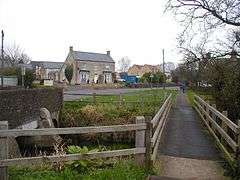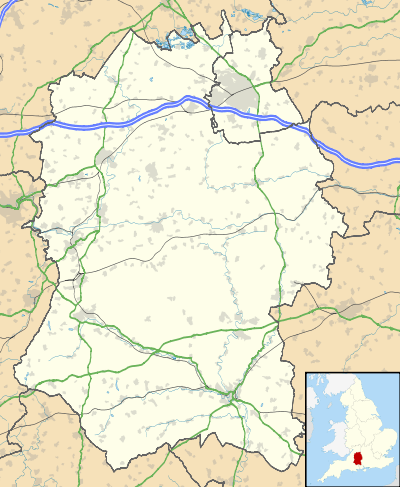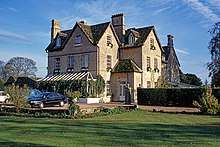Crudwell
Crudwell is a village and civil parish in north Wiltshire, England. The nearest towns are Malmesbury, about 4 miles (6.4 km) to the south-west, and Cirencester, Gloucestershire 8 miles (13 km) to the north-east. Also to the north-east is Cotswold Airport. Kemble village, about 4 miles (6.4 km) away, has the nearest railway station, with services to London Paddington and Gloucester.
| Crudwell | |
|---|---|
| Village | |
 Footbridge near the A429 | |
 Crudwell Location within Wiltshire | |
| Population | 1,057 (in 2011)[1] |
| OS grid reference | ST953928 |
| Unitary authority | |
| Ceremonial county | |
| Region | |
| Country | England |
| Sovereign state | United Kingdom |
| Post town | Malmesbury |
| Postcode district | SN16 |
| Dialling code | 01666 |
| Police | Wiltshire |
| Fire | Dorset and Wiltshire |
| Ambulance | South Western |
| UK Parliament | |
| Website | Parish Council |
Links and extent
The village lies on the A429 linking Cirencester and Malmesbury. This route south to Malmesbury opened as a turnpike in 1778.[2]
The parish includes the hamlets of Chedglow, Chelworth, Eastcourt, Murcott and West Crudwell. The Fosse Way, originally a Roman road, forms part of the parish and county boundary. The population of the parish changed little between 1831 (604) and 1951 (618).[1]
History
The Domesday Book of 1086 recorded a large population of 107 households at Crudwell, and smaller settlements at Chelworth and Chedglow.[3] Most of the parish belonged to Malmesbury Abbey's Brokenborough estate, which in the 13th century had a farmstead with a fishpond and a chapel.[2] A large barn still stands to the south of All Saints' Church, probably dating from the 15th century and now Grade II* listed.[4]
Manor Farm, east of the church, is probably from the 17th century, with additions in the 18th.[5] The old rectory, now a hotel, is from the early 18th century, altered in the late 19th.[6]
A school was founded at Crudwell in the 17th century by Lord Lucas. The schoolroom and schoolhouse of 1670 survive in residential use, south-west of the church.[7] A new school was built in 1857, alongside the older buildings, became a National School, and then in 1949 a voluntary controlled school.[8] A small school also opened at Eastcourt in about 1858 and became a National School. It closed in 1923 due to falling pupil numbers.[2]
RAF Kemble opened in 1938 in the north of the parish[2] and now serves as Cotswold Airport. It was a base for aircraft maintenance and ferrying, and later the home of the Red Arrows aerobatics display team. In the 1980s the airfield became a maintenance base for the US Air Force. Military flying ended in 1993 when the site was used to store surplus equipment. It was sold into private ownership in 2001 and now houses businesses carrying out aircraft maintenance and dismantling, and technical training.
Parish church
The Church of England Parish Church of All Saints, probably begun in the 11th century, is a Grade I listed building.[9][10] Work from the 12th–15th centuries can be seen, with alterations and restoration in the 17th and 19th.[11]
The 15th-century stained glass in a north-east window depicts the seven sacraments.[9] The tower has five bells, recast in 1858 by Mears.[9]
In 1151 the church belonged to Malmesbury Abbey, and Hankerton Church was dependent on it, but became a separate parish in 1445.[2] The rectories of Crudwell and St James, Ashley (Gloucestershire) were united in 1954,[12] and in 1987 the two churches joined with Hankerton and Oaksey to form the Braydon Brook group.[13]
Amenities

The village school, extended in 1969, continues as Crudwell CE Primary School. Crudwell has two pubs, The Potting Shed and the Wheatsheaf Inn, and two hotels, Mayfield House Hotel and The Rectory; the latter is a Grade II listed building.[6] The village also has a village hall and recreation ground, as well as a post office (housed within the Wheatsheaf Inn).
Of several annual village events, the two largest are the Crudwell Bike Ride (June), a 24-hour "Le Mans" style event that raises funds for the local village hall, and the Strawberry Fair (July), held on and around the village green. Both take up a weekend and attract visitors from outside the village.
Notable people
In birth order:
- George Ingram (1694–1763), rector from 1719 until his death[14]
- Ambrose McEvoy (1878–1927), artist[15]
- Walter Knight-Adkin (1880–1957), Chaplain of the Fleet[16]
- Richard Cooper (1945–1990), cricketer
- John Rawling Todd (1929–2002), colonial administrator in British Indian Ocean Territory and Hong Kong[17]
References
- "Wiltshire Community History – Census". Wiltshire Council. Retrieved 8 January 2015.
- Baggs, A. P.; Freeman, Jane; Stevenson, Janet H (eds.). "Victoria County History – Wiltshire – Vol 14 pp. 51–65 – Parishes: Crudwell". British History Online. University of London. Retrieved 21 May 2016.
- Crudwell in the Domesday Book
- Historic England. "Barn to the south-west of Manor Farmhouse (1181760)". National Heritage List for England. Retrieved 24 May 2016.
- Historic England. "Manor Farmhouse (1022233)". National Heritage List for England. Retrieved 24 May 2016.
- Historic England. "Crudwell Court (1022234)". National Heritage List for England. Retrieved 24 May 2016.
- Historic England. "School House and School Cottage (1022235)". National Heritage List for England. Retrieved 24 May 2016.
- "Crudwell Church of England Primary School". Wiltshire Community History. Wiltshire Council. Retrieved 23 May 2016.
- "All Saints Church, Crudwell". Wiltshire Community History. Wiltshire Council. Retrieved 21 May 2016.
- Historic England. "Church of All Saints (1363888)". National Heritage List for England. Retrieved 21 May 2016.
- "All Saints, Crudwell: About". Retrieved 21 May 2016.
- "No. 40176". The London Gazette. 18 May 1954. p. 2918.
- "Braydon Brook Churches". Retrieved 21 May 2016.
- Persons: Ingram, George (1718–1763) in "CCEd, the Clergy of the Church of England database" (Accessed online, 27 July 2017)
- Claude Johnson, ed., The Works of Ambrose McEvoy from 1900 to May 1919, 1919.
- "No. 33506". The London Gazette. 14 June 1929. p. 3943.
- "Deaths", Hatfield Record, 2004, p. 105.
External links
- "Crudwell". Wiltshire Community History. Wiltshire Council. Retrieved 20 May 2016.
- Crudwell Village Hall and Recreation Ground
- Crudwell community website
- Crudwell Parish Council
![]()